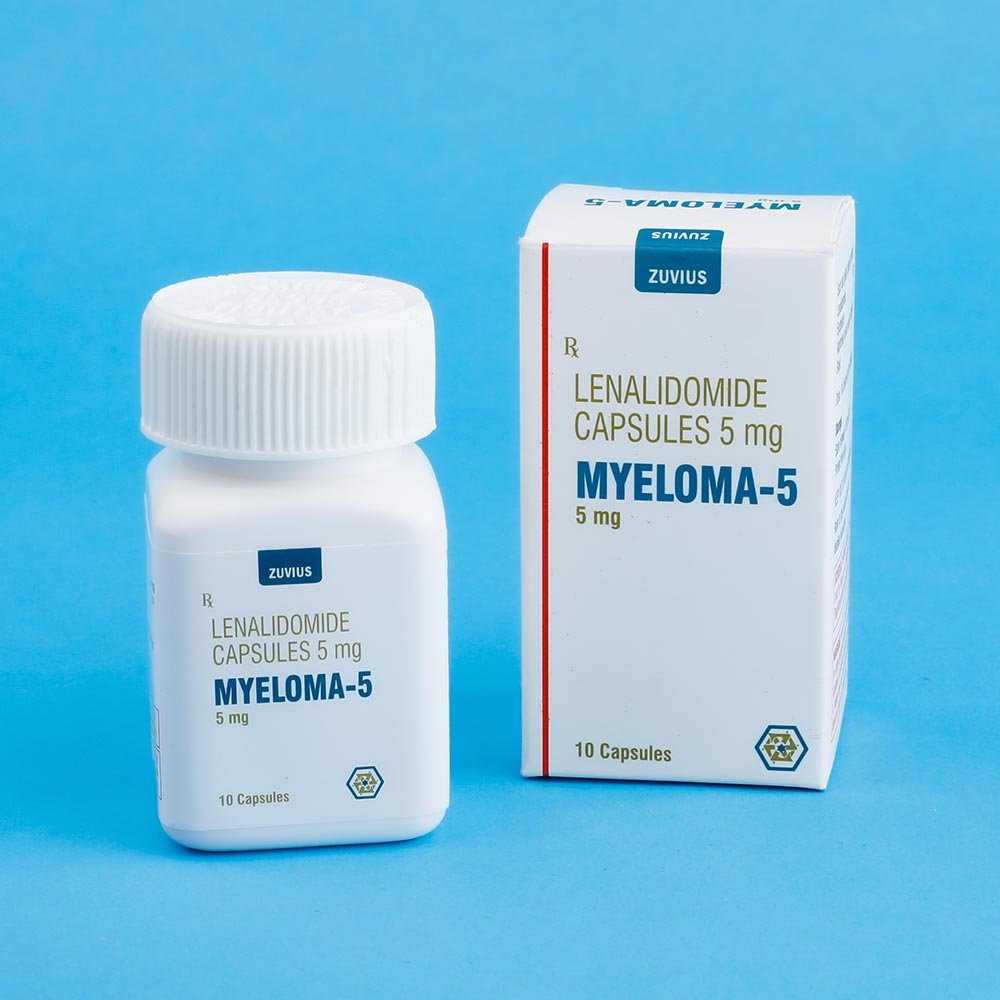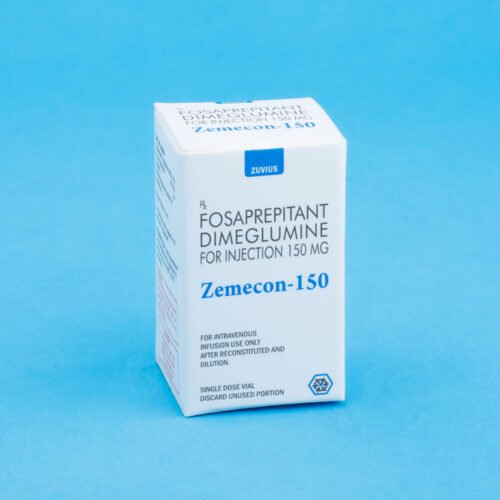Myeloma Cap
Lenalidomide Cap
Strength: 5mg / 10mg / 25mg
Pack Size: 1 x 10
Drug Class: Other immunosuppressants
Dosage and Administration:
DOSAGE AND ADMINISTRATION
Recommended Dosage For Multiple Myeloma
Lenalidomide Cap Combination Therapy
The recommended starting dose of REVLIMID is 25 mg orally once daily on Days 1-21 of repeated 28-day cycles in combination with dexamethasone. For patients greater than 75 years old, the starting dose of dexamethasone may be reduced Treatment should be continued until disease progression or unacceptable toxicity.
In patients who are not eligible for auto-HSCT, treatment should continue until disease progression or unacceptable toxicity. For patients who are auto-HSCT-eligible, hematopoietic stem cell mobilization should occur within 4 cycles of a Lenalidomide Cap -containing therapy
Dose Adjustments for Hematologic Toxicities During MM Treatment
Dose modification guidelines, as summarized in Table 1 below, are recommended to manage Grade 3 or 4 neutropenia or thrombocytopenia or other Grade 3 or 4 toxicity judged to be related to Lenalidomide Cap .Following auto-HSCT, initiate Lenalidomide Cap maintenance therapy after adequate hematologic recovery (ANC at least 1000/mcL and/or platelet counts at least 75,000/mcL). The recommended starting dose of Lenalidomide Cap is 10 mg once daily continuously (Days 1-28 of repeated 28-day cycles) until disease progression or unacceptable toxicity. After 3 cycles of maintenance therapy, the dose can be increased to 15 mg once daily if tolerated.
Dose Adjustments for Hematologic Toxicities During MM Treatment
Dose modification guidelines, as summarized in Table 2 below, are recommended to manage Grade 3 or 4 neutropenia or thrombocytopenia or other Grade 3 or 4 toxicity judged to be related to Lenalidomide Cap .Recommended Dosage For Myelodysplastic Syndromes
The recommended starting dose of REVLIMID is 10 mg daily. Treatment is continued or modified based upon clinical and laboratory findings. Continue treatment until disease progression or unacceptable toxicity.
Dose Adjustments For Hematologic Toxicities During MDS Treatment
Patients who are dosed initially at 10 mg and who experience thrombocytopenia should have their dosage adjusted as follows:
Platelet counts
If thrombocytopenia develops WITHIN 4 weeks of starting treatment at 10 mg daily in MDSRecommended Dosage For Mantle Cell Lymphoma
The recommended starting dose of Lenalidomide Cap is 25 mg/day orally on Days 1-21 of repeated 28-day cycles for relapsed or refractory mantle cell lymphoma. Treatment should be continued until disease progression or unacceptable toxicity.
Treatment is continued, modified or discontinued based upon clinical and laboratory findings.
Dose Adjustments For Hematologic Toxicities During MCL Treatment
Dose modification guidelines as summarized below are recommended to manage Grade 3 or 4 neutropenia or thrombocytopenia or other Grade 3 or 4 toxicities considered to be related to Lenalidomide Cap Dosage For Follicular Lymphoma Or Marginal Zone Lymphoma
The recommended starting dose of REVLIMID is 20 mg orally once daily on Days 1-21 of repeated 28-day cycles for up to 12 cycles of treatment in combination with a rituximab-product. Refer to Section 14.4 for specific rituximab dosing from the AUGMENT trial. For dose adjustments due to toxicity with rituximab, refer to the product prescribing information.
Dose Adjustments For Hematologic Toxicities During FL Or MZL Treatment
Dose modification guidelines, as summarized below, are recommended to manage Grade 3 or 4 neutropenia or thrombocytopenia or other Grade 3 or 4 toxicity judged to be related to Lenalidomide Cap Modifications For Non-Hematologic Adverse Reactions
For non-hematologic Grade 3/4 toxicities judged to be related to REVLIMID, hold treatment and restart at the physician’s discretion at next lower dose level when toxicity has resolved to Grade 2 or below.
Cold Storage: no
a thalidomide analogue, is an immunomodulatory agent with antiangiogenic and antineoplastic properties. The chemical name is 3-(4-amino-1-oxo 1,3- dihydro-2H-isoindol-2-yl) piperidine-2,6-dione and it has the following chemical structure:
 |
3-(4-amino-1-oxo 1,3-dihydro-2H-isoindol-2-yl) piperidine-2,6-dione
The empirical formula for lenalidomide is C13H13N3O3, and the gram molecular weight is 259.3.
Lenalidomide is an off-white to pale-yellow solid powder. It is soluble in organic solvent/water mixtures, and buffered aqueous solvents. Lenalidomide is more soluble in organic solvents and low pH solutions. Solubility was significantly lower in less acidic buffers, ranging from about 0.4 to 0.5 mg/ml. Lenalidomide has an asymmetric carbon atom and can exist as the optically active forms S(-) and R(+), and is produced as a racemic mixture with a net optical rotation of zero.
Multiple Myeloma
REVLIMID in combination with dexamethasone is indicated for the treatment of adult patients with multiple myeloma (MM).
REVLIMID is indicated as maintenance therapy in adult patients with MM following autologous hematopoietic stem cell transplantation (auto-HSCT).
Myelodysplastic Syndromes
REVLIMID is indicated for the treatment of adult patients with transfusion-dependent anemia due to low- or intermediate-1-risk myelodysplastic syndromes (MDS) associated with a deletion 5q cytogenetic abnormality with or without additional cytogenetic abnormalities.
Mantle Cell Lymphoma
REVLIMID is indicated for the treatment of adult patients with mantle cell lymphoma (MCL) whose disease has relapsed or progressed after two prior therapies, one of which included bortezomib.
Follicular Lymphoma
REVLIMID in combination with a rituximab product, is indicated for the treatment of adult patients with previously treated follicular lymphoma (FL).
Marginal Zone Lymphoma
REVLIMID in combination with a rituximab product, is indicated for the treatment of adult patients with previously treated marginal zone lymphoma (MZL).
Usage-:
-The efficacy and safety of Myeloma – 10 maintenance was assessed in two phase 3 multicentre, randomised, double-blind 2-arm, parallel group, placebo-controlled studies: CALGB 100104 and IFM 2005-02
-The primary efficacy endpoint in the study was progression free survival (PFS). In total 523 patients were enrolled into the study, with 263 patients randomised to RVd and 260 patients randomised to Rd. The demographics and disease-related baseline characteristics of the patients were well balanced between arms.
-The safety and efficacy of Myeloma – 10 was assessed in a phase 3, multicentre, randomised, open-label, 3-arm study (MM-020) of patients who were at least 65 years of age or older or, if younger than 65 years of age, were not candidates for stem cell transplantation because they declined to undergo stem cell transplantation or stem cell transplantation is not available to the patient due to cost or other reason.
-The primary efficacy endpoint in the study was progression free survival (PFS). In total 1623 patients were enrolled into the study, with 535 patients randomised to Rd, 541 patients randomised to Rd18 and 547 patients randomised to MPT. The demographics and disease-related baseline characteristics of the patients were well balanced in all 3 arms. In general, study subjects had advanced-stage disease: of the total study population, 41% had ISS stage III, 9% had severe renal insufficiency (creatinine clearance [CLcr] < 30 mL/min). The median age was 73 in the 3 arms.
-The safety and efficacy of Myeloma – 10 was assessed in a phase 3 multicentre, randomised double blind 3 arm study (MM-015) of patients who were 65 years or older and had a serum creatinine < 2.5 mg/dL.
-The primary efficacy endpoint in the study was progression free survival (PFS). In total 459 patients were enrolled into the study, with 152 patients randomised to MPR+R, 153 patients randomised to MPR+p and 154 patients randomised to MPp+p.
if you are pregnant, think you may be pregnant or are planning to become pregnant, as Myeloma – 10 is expected to be harmful to an unborn child.
if you are able to become pregnant, unless you follow all the necessary measures to prevent you from becoming pregnant
If you are able to become pregnant, your doctor will record with each prescription that the necessary measures have been taken and provide you with this confirmation.
It is very important that your doctor check your progress closely at regular visits to see if the medicine is working properly and to allow for a change in the dose. Blood and urine tests may be needed to check for any unwanted effects.
Women should take the necessary precautions to avoid pregnancy while using lenalidomide. Begin 2 forms of reliable contraception 4 weeks before starting lenalidomide. Continue contraceptive measures during treatment and for at least 4 weeks after the last dose. Routine pregnancy tests are necessary with this medicine. Call your doctor for emergency contraception information if you think you are pregnant.
Men, even those who have had a vasectomy, must prevent pregnancy in their sexual partners during treatment with this medicine and for at least 4 weeks after the last dose. Do not donate sperm while using this medicine. Call your doctor for emergency contraception information if you think your sexual partner may be pregnant.
Do not donate blood during treatment and for at least 4 weeks after the last dose.
This medicine lowers the number of some types of blood cells in your body. Because of this, you may bleed or get infections more easily. To help with these problems, avoid being near people who are sick or have infections. Wash your hands often. Stay away from rough sports or other situations where you could be bruised, cut, or injured. Brush and floss your teeth gently. Be careful when using sharp objects, including razors and fingernail clippers.
This medicine may increase your risk of having blood clots
















